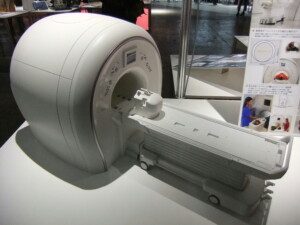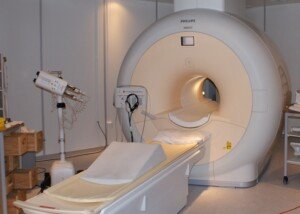
Why are CT scans used so much more than MRI’s for suspected brain bleeds from head trauma when CT scans emit lots of radiation?
MRI vs. CT Scan for Suspected Bleeding in the Brain
The MRI may very well win over the CT scan for people who hit their head or otherwise experience mild brain injury from blunt force, says a study from the University of California, San Francisco and the San Francisco General Hospital and Trauma Center.
Both my parents have fallen and hit their heads: my mother twice and my father once.
All three times, they got CT scans in the emergency room. The CT scans (in the ER and next day) for my mother’s first fall were normal.
For the second fall, the ER and next-day scans were also normal.
However, six weeks after the second fall when my mother developed neurological symptoms, the CT scan showed a brain bleed. My father’s ER and next-day CT scans were normal.
At the time of me writing this article, he is still within the “incubation period” for a brain bleed to develop, and I’m on the lookout for neurological symptoms.
MRI?
The UCSF study followed 135 people over two years who had mild traumatic brain injuries.
They had CT scans. The CT scans for 99 were normal. A week later all the patients had an MRI.
Out of those 99, 27 had MRI’s positive for a brain bleed.
I’ve always wondered why MRI was not used for my parents.
I figured this was because MRI’s take longer, but why should this matter if my parents had not exhibited alarming neurological symptoms in the ER? Why isn’t MRI the standard?
Perhaps an emergency room MRI could have shown the brain bleed in my mother that began generating symptoms six weeks later!
“Having a normal CT scan doesn’t, in fact, say you’re normal,” states the research paper.
In-Depth Comparison of MRI vs. CT Scan for Head Trauma

MRI scanner. Mj-bird, CC BY-SA 3.0/creativecommons.org
“When a doctor makes decisions on how to treat a patient, they are always weighing a risk/reward profile to determine what is the best option for the patient,” says Scott Schultz, MD, a board-certified emergency medicine physician.
The answer to, “Why aren’t MRI’s used instead of CT scanners for head imaging in the emergency room?” is multi-factorial.
Dr. Schultz points out the following logistical reasons.
• Some ER’s actually don’t have an MRI machine.
• “Even when a hospital does have a machine, they are quite often not available quickly,” says Dr. Schultz.
• If the patient comes in overnight, there may not be an MRI technician available.
• “The CT scanner is usually placed directly adjacent to the ER for emergency use.
“If there is another routine scan scheduled for the CT scanner, the ER patient will take their spot if it’s an emergency.
• “MRI’s are usually located in locations like the basement,” due to their heaviness, plus “their large magnet can disrupt other machines if not shielded appropriately.
• “If a physician is concerned enough about a patient to get imaging for intracranial hemorrhage, she would most likely consider them unstable, and they will need to be close to us in case something bad happens.
“In the basement, where you cannot have a lot of necessary equipment in the room because of the big magnet, is not a good idea.”
Dr. Schultz also says there are patient and doctor centered reasons for why the CT scanner is the mode of choice, despite its radiation.
A small number of people can’t tolerate the MRI’s enclosure.
“Patients with intracranial hemorrhage are likely not to be completely coherent, and this makes it difficult for them to lay still for the MRI.
“You typically wouldn’t want to medicate a patient before knowing the status of the brain.”
What about radiation risk?
“Radiation risk is real, but very very small,” says Dr. Schultz.
“It’s estimated that it causes cancer in about 0.01% of pediatric patients who get a CT scan.
“This is definitely a horrible risk, and is not taken lightly, but relatively speaking, very rare.
What about a CT scan missing a diagnosis that an MRI might pick up?
“CT scans are very accurate,” says Dr. Schultz.
“If there is a lesion of any significant size, it is almost always going to pick it up.
“But if the physician still is concerned, they will admit the patient to the hospital and monitor their status.
“If the patient continues to have concerning symptoms in the future, the hospitalist will typically order more testing, usually an MRI.
“Remember, in the ER, the No. 1 priority is to determine if there is an issue that needs immediate action to be taken.
“Do I need to call in a neurosurgeon tonight because the patient has a leaking aneurysm?”
No MRI Phobia, No Acute Rapid Symptoms
What if the patient got hit in the head two months ago, rather than two days ago, and thus, the new symptoms would suggest a slow bleed rather than a rapid one?
And what if they don’t have an MRI phobia?
Dr. Schultz explains, “If all other things were equal (speed, resources and financial), an MRI would most likely be preferred, but just marginally.
“But that isn’t how the sausage is made, if you will. The patient who presents like this is going to be elderly.”
A younger person who experiences the same head impact will not acquire an insidious brain bleed because their brain is bigger {less room for veins to get torn).
“The chances of cancer in their [elderly] lifetime from radiation are incredibly small.
“So even with no logistical issues, the choice could be a coin flip in my mind.
“In reality, all the previous limitations of MRI’s are real and a huge pressure on ER physicians.”
UPDATE: My father was discharged in a timely fashion as his neurological symptoms faded, and he never developed any delayed new neurological symptoms.
The MRI vs. CT scan report is in Annals of Neurology (Dec. 2012), led by Esther Yuh, MD.
 Dr. Schultz worked for 5+ years at a level 1 trauma center at the University of Missouri. After witnessing deaths from overheating in the ER, he’s been devoting his life to the prevention of heat related illness. His app, Zelus WBGT, alerts users when it gets too hot outside to continue their physical activity.
Dr. Schultz worked for 5+ years at a level 1 trauma center at the University of Missouri. After witnessing deaths from overheating in the ER, he’s been devoting his life to the prevention of heat related illness. His app, Zelus WBGT, alerts users when it gets too hot outside to continue their physical activity.
 Lorra Garrick has been covering medical, fitness and cybersecurity topics for many years, having written thousands of articles for print magazines and websites, including as a ghostwriter. She’s also a former ACE-certified personal trainer.
Lorra Garrick has been covering medical, fitness and cybersecurity topics for many years, having written thousands of articles for print magazines and websites, including as a ghostwriter. She’s also a former ACE-certified personal trainer.
.









































